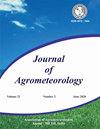Weather induced physiological responses on the flowering habits of neem trees (Azadirachta indica)
Q3 Agricultural and Biological Sciences
引用次数: 0
Abstract
Adaptability and significant economic value of the neem tree are well-known, as it can flourish in a variety of environmental conditions. While the neem seed production is highly sensitive to prevailing weather conditions during the reproductive phase and flowering behaviour of the tree. A study was conducted at Tamil Nadu Agricultural University, Coimbatore in 2023 with the primary objective of validating the weather influence on neem seed production using the logics of physiological responses, as a continuation of research conducted the previous year (2022). During the pre-flowering and flowering stages, diverse weather conditions led to notable changes in the physiological traits of neem trees, which displayed varying patterns of flowering. Trees that flowered consistently showed elevated levels of indole acetic acid (IAA) oxidase, relative water content, and nitrate reductase compared to those that lacked flowers or produced intermittently. In the flowering stage, the neem trees responded positively in terms of physiological aspects like IAA oxidase, relative water content, nitrate reductase, and exhibited lower proline levels, which can be attributed to the optimal maximum temperature, rainfall, and soil moisture. Proline levels rose during the pre-flowering stage due to soil moisture deficits but fell during the flowering stage with the onset of rain. These physiological changes, driven by climatic factors, are likely to enhance the flowering, fruiting, and overall yield of neem trees.天气对印度楝树(Azadirachta indica)开花习性的生理反应
楝树的适应性和重要经济价值是众所周知的,因为它可以在各种环境条件下生长茂盛。楝树种子的产量对楝树生殖期和开花期的天气条件非常敏感。2023 年,哥印拜陀泰米尔纳德邦农业大学开展了一项研究,主要目的是利用生理反应逻辑验证天气对楝树种子产量的影响,作为前一年(2022 年)研究的延续。在开花前和开花期,不同的天气条件导致楝树的生理特征发生显著变化,开花模式也各不相同。与不开花或间歇性开花的楝树相比,持续开花的楝树的吲哚乙酸(IAA)氧化酶、相对含水量和硝酸还原酶水平较高。在开花阶段,楝树在吲哚乙酸氧化酶、相对含水量、硝酸还原酶等生理方面表现出积极的反应,并表现出较低的脯氨酸水平,这可归因于最适宜的最高温度、降雨量和土壤湿度。脯氨酸水平在花前阶段因土壤水分不足而上升,但在开花阶段随着降雨的到来而下降。这些由气候因素驱动的生理变化可能会提高楝树的开花、结果和总产量。
本文章由计算机程序翻译,如有差异,请以英文原文为准。
求助全文
约1分钟内获得全文
求助全文
来源期刊

Journal of Agrometeorology
农林科学-农艺学
CiteScore
1.40
自引率
0.00%
发文量
95
审稿时长
>12 weeks
期刊介绍:
The Journal of Agrometeorology (ISSN 0972-1665) , is a quarterly publication of Association of Agrometeorologists appearing in March, June, September and December. Since its beginning in 1999 till 2016, it was a half yearly publication appearing in June and December. In addition to regular issues, Association also brings out the special issues of the journal covering selected papers presented in seminar symposia organized by the Association.
 求助内容:
求助内容: 应助结果提醒方式:
应助结果提醒方式:


